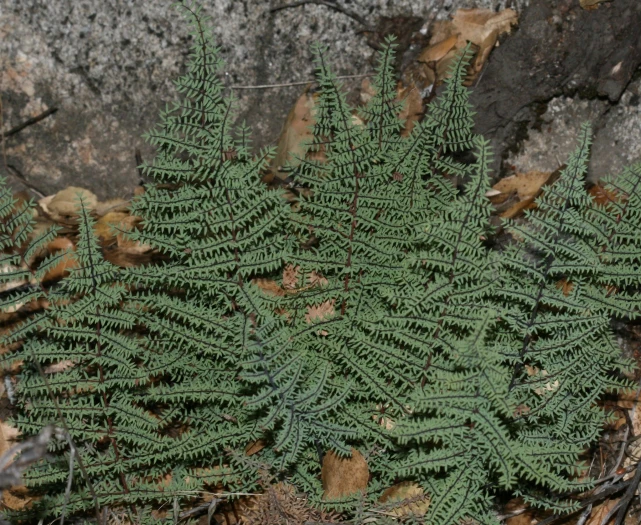Bird’s Foot Cliffbrake
(Pellaea mucronata)
Bird’s Foot Cliffbrake (Pellaea mucronata)
/
/

S. Rae
CC BY 2.0
Image By:
S. Rae
Recorded By:
Copyright:
CC BY 2.0
Copyright Notice:
Photo by: S. Rae | License Type: CC BY 2.0 | License URL: https://creativecommons.org/licenses/by-sa/2.0/ | Uploader: S. Rae | Publisher: Flickr |























































Estimated Native Range
Climate Requirements for North Laurel, Maryland
| This Plant | Your Site | Plant Suitability for Your Location | ||
|---|---|---|---|---|
| • Precipitation | 3" - 63" | 45" | Aquatic | Aquatic |
| • High Temp. | 68°F - 109°F | 87°F | Your summer temperatures are normal for this plant. | Excellent |
| • Low Temp. | 11°F - 52°F | 24°F | Your winter temperatures are normal for this plant | Excellent |
This plant may not grow well at your location - your precipitation is too high.
Summary
Pellaea mucronata, commonly known as Bird’s Foot Cliffbrake, is a deciduous perennial fern native to rocky slopes, cliffs, and canyons within chaparral, woodlands, and scrub areas in the Southwestern USA and Baja California in Northwest Mexico. It typically grows to a height and width of 0.2-2 feet, forming clumps of blue-green, finely divided fronds that are drought-resistant once established. The fronds are somewhat leathery in texture and have a distinctive bird’s foot shape, which gives the plant its common name. Flowering is not applicable to ferns, as they reproduce via spores found on the undersides of the fronds.
Bird’s Foot Cliffbrake is valued for its ability to thrive in dry, rocky conditions and is often used in rock gardens, as a ground cover, or in xeriscaping. It is appreciated for its unique foliage texture and form, which adds visual interest to garden compositions. This fern prefers full sun to part shade and requires well-drained soil. It is relatively low maintenance, needing minimal water once established, and does not have serious disease or pest issues. However, it is important to avoid overwatering to prevent root rot.CC BY-SA 4.0
Bird’s Foot Cliffbrake is valued for its ability to thrive in dry, rocky conditions and is often used in rock gardens, as a ground cover, or in xeriscaping. It is appreciated for its unique foliage texture and form, which adds visual interest to garden compositions. This fern prefers full sun to part shade and requires well-drained soil. It is relatively low maintenance, needing minimal water once established, and does not have serious disease or pest issues. However, it is important to avoid overwatering to prevent root rot.CC BY-SA 4.0
Plant Description
- Plant Type: Herb
- Height: 0.2-1.5 feet
- Width: 0.2-1.5 feet
- Growth Rate: Slow
- Flower Color: N/A
- Flowering Season: Non-Flowering
- Leaf Retention: Deciduous
Growth Requirements
- Sun: Full Sun
- Water: Low
- Drainage: Medium, Fast
Common Uses
Low Maintenance
Natural Habitat
Native to rocky slopes, cliffs, and canyons within chaparral, woodlands, and scrub areas in the Southwestern USA and Baja California in Northwest Mexico
Other Names
Common Names: Birdfoot Cliffbrake
Scientific Names: Pellaea mucronata, Pellaea mucronata var. mucronata, Pellaea macronata
GBIF Accepted Name: Pellaea mucronata (D.C.Eaton) D.C.Eaton